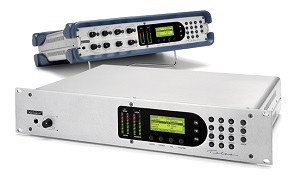Hunting Robots and Cranking it Up | Telos Alliance
By The Telos Alliance Team on Oct 8, 2014 10:00:00 PM
 Hunting Robots and Cranking it Up
Hunting Robots and Cranking it Up
In this edition, we focus on some technical tips regarding Telos Zephyr and Nx Phone Systems.
Tip #1: I, Robot Hunter
From Lotus Broadcasting in Las Vegas NV, Bill Croghan writes:
“Our station has issues with robo-dialers calling into the second line of our Zephyr Xstream during sports talk shows. We carry the show on a single B channel using g.722 for send and receive 64/48. We sum the two lines at the output for our AM studios and use the stereo out for the FM studios. This occurs when we are using the filed Xstreams, and also when we use our older Zephyrs or our AEQ units in the field.
“Is there some way we can prevent these unsolicited calls to that second line from robo-dialers? It is disconcerting and difficult to hang up on them while a show is in progress. I could change the way we feed, but there are times when an outside source feeds us in stereo — even for our AMs.”
Ted Alexander of Engineering Support replies:
“You can prevent an incoming voice mode call from being automatically answered on a Zephyr Xstream by selecting ISDN on the Auto Ans. menu field and ISDN on the Interface field. The caveat is that unless you set the Volume adjustment in the SYSTEM menu to zero, you will hear the incoming ring (from the internal speaker) from that unsolicited call. But, at least it will not answer.”
If you never use the Circuit Switched Voice mode (POTS call to an ISDN line), you may want to remove the CSV option from the ISDN line. That would need to be done through a provisioning change order from the ISDN line provider.
Tip #2: Pump Up the Volume
Rob at Sandusky Seattle writes:
“We are getting complaints about the audio on our NX phone system sending low levels from the studio to the caller. I only have 3 systems running so far, and they all seem to have this issue.
“When I check it, the level seems sufficient at best. While the audio is clean, it sounds pretty thin, almost like there's some phase cancellation going on. This happens with the hand set as well as the regular AES audio input. The board levels going in are right at the edge of the red LED meter.
“Are there any updates to separate the gain of the hand set earphone level from the hand set mic gain? In order for the caller to hear the studio using the hand set it has to be set to 8 or higher, which is too loud in the DJ’s ear piece.”
Ted Alexander answers again:
“The maximum send-to-caller level in the Nx system is achieved when you set the PHONE SEND ADJ to ‘+2’. That’s the level limit which we are permitted to send to the PSTN. Anything above that violates FCC rules. As long as you are peaking just to the ‘red’ on the input meters, you are maxing out the send-to-caller level. Increasing the input level beyond that can cause distortion and poor hybrid action.
“You can adjust the receive EQ a couple of dB at a time to add more HF or LF audio to the caller output to your board to counteract the ‘thin’ sound you describe.
Follow-Up: The handset’s earphone level gain is not separately adjustable from the handset mic gain. However, we have had a few reports of low handset send audio from Desktop Director handsets due to damage (spillage, rough handling) to the handset’s microphone. Try switching handsets around to see if one of the handsets or the cord may have been damaged.
Telos Alliance has led the audio industry’s innovation in Broadcast Audio, Digital Mixing & Mastering, Audio Processors & Compression, Broadcast Mixing Consoles, Audio Interfaces, AoIP & VoIP for over three decades. The Telos Alliance family of products include Telos® Systems, Omnia® Audio, Axia® Audio, Linear Acoustic®, 25-Seven® Systems, Minnetonka™ Audio and Jünger Audio. Covering all ranges of Audio Applications for Radio & Television from Telos Infinity IP Intercom Systems, Jünger Audio AIXpressor Audio Processor, Omnia 11 Radio Processors, Axia Networked Quasar Broadcast Mixing Consoles and Linear Acoustic AMS Audio Quality Loudness Monitoring and 25-Seven TVC-15 Watermark Analyzer & Monitor. Telos Alliance offers audio solutions for any and every Radio, Television, Live Events, Podcast & Live Streaming Studio With Telos Alliance “Broadcast Without Limits.”
Recent Posts
Subscribe
If you love broadcast audio, you'll love Telos Alliance's newsletter. Get it delivered to your inbox by subscribing below!